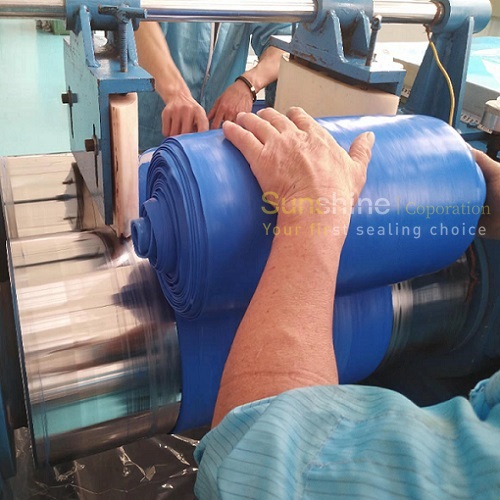Fluorosilicone Compound for Molding Parts
Fluorosilicone Compound for Molding Parts is used for molding gaskets, seal and parts
Content
What is Fluorosilicone Compound for Molding Parts?
Fluorosilicone compound for molding parts is used for making all kinds of molded Fluorosilicone parts such as gaskets, seals, custom sealing parts. Fluorosilicone compound for molding parts has high tear strength, good mechanical properties and excellent solvent, oil, fuel resistance. It maintains properties over a wide temperature range from -60°C to 230°C.Processing
Various organic peroxides will vulcanize these fluorosilicone compound for molding parts. The optimum curing procedures will depend on the process methods you use and the physical dimensions of the vulcanized product. It is usually necessary to post cure the products in air oven after molded cure.

What is Rubber Molding?
The rubber molding process encompasses three key components:• The custom-designed mold to make the desired part or product
• The raw material which is placed or injected into the mold
• The molding machine to hold the mold and place/inject the material
• Together, these three elements enable rubber molding companies to manufacture various components in different shapes and sizes.
Steps in the Fluorosilicone Rubber Molding Process
The steps in the fluorosilicone rubber molding process are as follows:1. Creating the mold for the component
2. Installing the mold within the molding machine
3. Placing or injecting the material into the mold
4. Applying heat and pressure to cure (vulcanize) the material
5. Removing the finished component from the machine
These steps may vary slightly depending on the type of rubber molding method used for the project. The three most commonly utilized are:
• Injection molding: rubber is injected at high pressures into a closed mold and then heated
• Compression molding: rubber is placed into a mold, which is then closed and subjected to heat and pressure
• Transfer molding: pre-formed rubber is inserted into a pot, forced through a runner and gate system into molding cavity, and then cured
Advantages of Fluorosilicone Rubber Molding
There are many advantages that rubber molding can bring to a production. For example, Fluorosilicone molding rubber products is one way to produce highly detailed three-dimensional shapes. Some of the other reasons manufacturers use it include:• It is fast - The rubber molding process offers fast cycle times, which helps reduce overall production time for projects.
• It is efficient - Manufacturers can utilize the same molding machine to create a variety of parts and products by simply changing out the mold. As a result, rubber molding offers high machine efficiency rates.
• It is economical - Rubber molding can be amenable to automation, which enables manufacturers to lower operational costs.
• It is precise and accurate - Molded rubber components can be made to a high degree of precision and accuracy, depending on the method and material. This allows manufacturers to achieve high dimensional tolerances and good surface finishes.
Applications of Fluorosilicone Rubber Molding
Molded fluorosilicone rubber parts and products find application in a wide range of industries. Typical components produced include: Backflow preventers, elastomeric, check valves, Electrical enclosures, Seal and gaskets, Surgical instruments and devices.High Rebound Resilience, Low Compression Set Fluorosilicone Rubber Compounds
|
Testing Item |
Testing Method | FVMQ-5130 | FVMQ-5140 | FVMQ-5150 | FVMQ-5160 | FVMQ-5170 | FVMQ-5180 |
| Color | - |
Translucent or milky color |
Translucent or milky color |
Translucent or milky color |
Translucent or milky color |
Translucent or milky color |
Translucent or milky color |
| Hardness (Shore A) | ASTM D2240 | 30 | 40 | 50 | 60 | 70 | 80 |
| Tensile Strength (Mpa) | ASTM D412 | 9.7 | 10.5 | 10.5 | 11 | 10.2 | 8.8 |
| Elongation at break (100%) | ASTM D412 | 420 | 415 | 350 | 330 | 270 | 210 |
| Tear Strength (KN/m) Die B | ASTM D624 | 16 | 17.5 | 17.3 | 18 | 18 | 17.2 |
| Compression Set % (177°C @22 Hrs) | ASTM D395 | 6 | 6.1 | 6.1 | 6.3 | 6.7 | 6.8 |
| Volume Change % (23°C@72 Hrs Fuel C) | ASTM D471 | 17 | 16 | 16 | 17 | 17.1 | 16.8 |
|
Elongation Change % (23°C@72 Hrs Fuel C) |
ASTM D471 | -20 | -21 | -20 | -21 | -22 | -21 |
Data Sheet of High Tear Strength Fluorosilicone Rubber Compound
|
Testing Item |
Testing Method | FVMQ-5340 | FVMQ-5350 | FVMQ-5360 | FVMQ-5370 | FVMQ-5380 |
| Color | - |
Translucent/Gray Color |
Translucent/Gray Color |
Translucent/Gray Color |
Translucent/Gray Color |
Translucent/Gray Color |
| Hardness (Shore A) | ASTM D2240 | 40 | 50 | 60 | 70 | 80 |
| Tensile Strength (Mpa) | ASTM D412 | 11.5 | 11.5 | 11.8 | 9.5 | 8.8 |
| Elongation at break (100%) | ASTM D412 | 480 | 425 | 390 | 330 | 180 |
| Tear Strength (KN/m) Die B | ASTM D624 | 41 | 43 | 42 | 36 | 30 |
| Compression Set % (177°C @22 Hrs) | ASTM D395 | 13 | 14 | 17 | 16 | 19 |
| Volume Change % (23°C@72 Hrs Fuel C) | ASTM D471 | 17 | 16.6 | 16.5 | 17 | 16.8 |
|
Elongation Change % (23°C@72 Hrs Fuel C) |
ASTM D471 | -20 | -21 | -20 | -21 | -20 |

